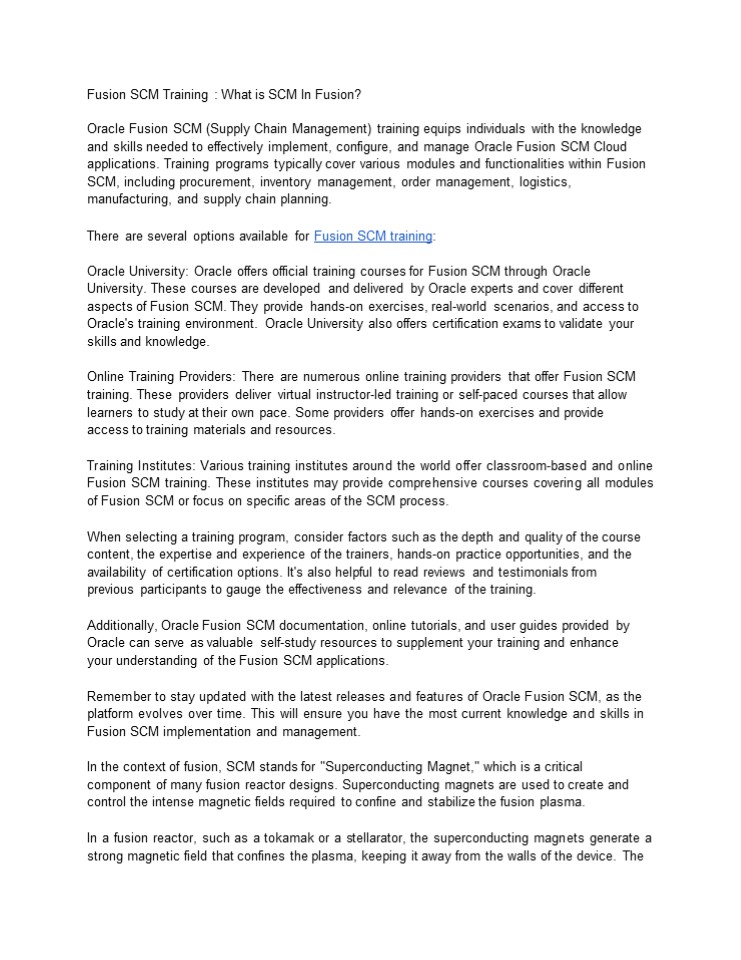Fusion SCM Training : What is SCM In Fusion? PowerPoint PPT Presentation
Title: Fusion SCM Training : What is SCM In Fusion?
1
Fusion SCM Training What is SCM In
Fusion? Oracle Fusion SCM (Supply Chain
Management) training equips individuals with the
knowledge and skills needed to effectively
implement, configure, and manage Oracle Fusion
SCM Cloud applications. Training programs
typically cover various modules and
functionalities within Fusion SCM, including
procurement, inventory management, order
management, logistics, manufacturing, and supply
chain planning. There are several options
available for Fusion SCM training Oracle
University Oracle offers official training
courses for Fusion SCM through Oracle
University. These courses are developed and
delivered by Oracle experts and cover different
aspects of Fusion SCM. They provide hands-on
exercises, real-world scenarios, and access to
Oracle's training environment. Oracle University
also offers certification exams to validate your
skills and knowledge. Online Training Providers
There are numerous online training providers that
offer Fusion SCM training. These providers
deliver virtual instructor-led training or
self-paced courses that allow learners to study
at their own pace. Some providers offer hands-on
exercises and provide access to training
materials and resources. Training Institutes
Various training institutes around the world
offer classroom-based and online Fusion SCM
training. These institutes may provide
comprehensive courses covering all modules of
Fusion SCM or focus on specific areas of the SCM
process. When selecting a training program,
consider factors such as the depth and quality of
the course content, the expertise and experience
of the trainers, hands-on practice opportunities,
and the availability of certification options.
It's also helpful to read reviews and
testimonials from previous participants to gauge
the effectiveness and relevance of the
training. Additionally, Oracle Fusion SCM
documentation, online tutorials, and user guides
provided by Oracle can serve as valuable
self-study resources to supplement your training
and enhance your understanding of the Fusion SCM
applications. Remember to stay updated with the
latest releases and features of Oracle Fusion
SCM, as the platform evolves over time. This
will ensure you have the most current knowledge
and skills in Fusion SCM implementation and
management. In the context of fusion, SCM stands
for "Superconducting Magnet," which is a critical
component of many fusion reactor designs.
Superconducting magnets are used to create and
control the intense magnetic fields required to
confine and stabilize the fusion plasma. In a
fusion reactor, such as a tokamak or a
stellarator, the superconducting magnets generate
a strong magnetic field that confines the
plasma, keeping it away from the walls of the
device. The
2
plasma, which consists of charged particles, is
heated to extremely high temperatures to initiate
and sustain fusion reactions. Superconducting
magnets are preferred in fusion reactors because
they can generate high magnetic fields without
dissipating energy in the form of heat, which is
crucial for the overall efficiency of the
system. These magnets operate at extremely low
temperatures, typically close to absolute zero,
which allows them to achieve a superconducting
state where electrical resistance is virtually
eliminated. The superconducting magnet system in
a fusion reactor typically consists of coils made
from superconducting materials, such as
niobium-titanium or niobium-tin. These coils are
cooled using cryogenic systems to maintain their
low-temperature superconducting properties. The
design and construction of superconducting
magnets for fusion reactors are complex and
challenging due to the high magnetic field
requirements, the need for cryogenic cooling, and
the mechanical stresses they endure. However,
advances in superconducting materials and
technology have made significant progress in the
development of these magnets, enabling the
construction of more efficient and powerful
fusion devices.

